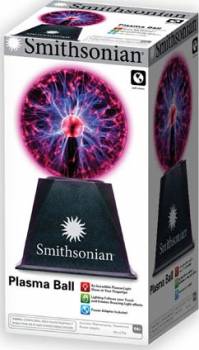Control lightning with this desktop sized plasma ball. A small Tesla coil generates a large electrical potential difference, which tries to even itself out by discharging in the same way that a cloud discharges lightning. Watch the plasma streams move toward your uncharged finger as you touch the 5 inch diameter ball, or make them respond to sound and music!
Electrical engineer Nikola Tesla invented the plasma globe when he was studying high-voltage phenomena in the late 19th century. The device is simple: a glass globe with an electrode inside. The ball is filled with inert gases—often neon and argon—at slightly below atmospheric pressure.
When you apply voltage to the electrode by turning the plasma globe on, it creates an alternating current that creates an electromagnetic field inside the ball. The first current sets the electrons in motion; the second current changes their path, which results in the colorful ribbons of light that dance up the sides of the globe.
The color (usually pinkish-purple) is a result of the gases. The high voltage that’s created inside the globe causes electrons to break free of the electrode in the center. As these electrodes break away, they accelerate, gaining energy and giving an electrical charge to the gas—ionizing it. As the electrons continue to pass through the gas, the excited gas particles have to find a way to give off some of the energy they’re gaining. They do this in the form of photons, or light. Different gases give off different colored light. Neon is red with pinkish-orange “fingers” at the ends, and argon is purple.
When you place your finger on the globe, it acts as a conductor of electricity, changing the electromagnetic field and attracting the plasma. Just don’t leave your finger in one spot for too long. All that electric charge builds up and can begin to warm the glass.















